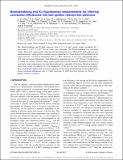Bremsstrahlung and K alpha fluorescence measurements for inferring conversion efficiencies into fast ignition relevant hot electrons
Author(s)
Chen, C. D.; Patel, P. K.; Hey, D. S.; Mackinnon, A. J.; Key, M. H.; Akli, K. U.; Bartal, T.; Beg, F. N.; Chawla, S.; Chen, H.; Freeman, R. R.; Higginson, D. P.; Link, A.; Ma, T. Y.; MacPhee, A. G.; Stephens, R. B.; Van Woerkom, L. D.; Westover, B.; Porkolab, Miklos; ... Show more Show less
DownloadChen_Bermsstrahlung.PDF (735.0Kb)
PUBLISHER_POLICY
Publisher Policy
Article is made available in accordance with the publisher's policy and may be subject to US copyright law. Please refer to the publisher's site for terms of use.
Terms of use
Metadata
Show full item recordAbstract
The Bremsstrahlung and K-shell emission from 1×1×1 mm[superscript 3] planar targets irradiated by a short-pulse 3×10[superscript 18]–8×10[superscript 19] W/cm[superscript 2] laser were measured. The Bremsstrahlung was measured using a filter stack spectrometer with spectral discrimination up to 500 keV. K-shell emission was measured using a single photon counting charge coupled device. From Monte Carlo modeling of the target emission, conversion efficiencies into 1–3 MeV electrons of 3%–12%, representing 20%–40% total conversion efficiencies, were inferred for intensities up to 8×10[superscript 19] W/cm[superscript 2]. Comparisons to scaling laws using synthetic energy spectra generated from the intensity distribution of the focal spot imply slope temperatures less than the ponderomotive potential of the laser. Resistive transport effects may result in potentials of a few hundred kV in the first few tens of microns in the target. This would lead to higher total conversion efficiencies than inferred from Monte Carlo modeling but lower conversion efficiencies into 1–3 MeV electrons.
Date issued
2009-08Department
Massachusetts Institute of Technology. Plasma Science and Fusion CenterJournal
Physics of Plasmas
Publisher
American Institute of Physics
Citation
Chen, C. D. et al. “Bremsstrahlung and K alpha fluorescence measurements for inferring conversion efficiencies into fast ignition relevant hot electrons.” Physics of Plasmas 16.8 (2009): 082705-10.
© 2009 American Institute of Physics
Version: Final published version
ISSN
1070-664X